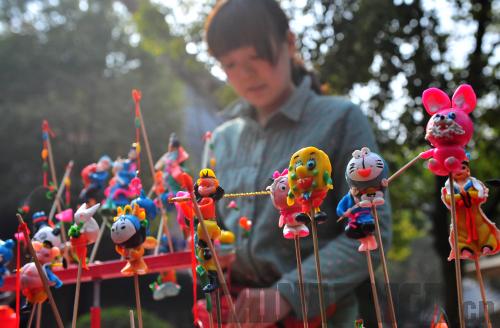|
 |
|
FOLK COLOR: Dough figurines are now seldom seen on Chinese streets (CHENG MIN) |
Wheat dough is typically molded into noodles and bread – but for 36-year-old Xu Haifeng, it's material for sculpting works of art.
Walking into the sculptor's workshop is like entering the land of Lilliput from Gulliver's Travels. Most of Xu's pieces depict images like Chinese zodiac signs and cartoon figures like Mickey Mouse, Snoopy and Hello Kitty. The allure of his work is found in these figurines' vivid facial expressions, their delicate clothes and in Xu's attention to color. Some figurines are so finely detailed that they include eyelashes, teeth and fingernails.
Xu's desk is littered with tools and materials for molding dough sculptures. "Everything you need can be found in the kitchen – wheat flour, scissors, knives, toothpicks, Chinese dates and Chinese prickly ash," he said.
Xu adds bee honey and other ingredients to his flour mixtures, which make the dough smooth and easy to shape. With well-kneaded dough in his hands, he skillfully shapes it into human figures or a lively animal within minutes. Various mineral pigments are used to create different colors of dough resistant to fading over time. A sprinkle of antiseptic adds durability to the finished figurines, allowing them to last years without spoiling.
Heritage
According to Xu, dough sculpting is a nearly 2,000-year-old practice. Written records on Chinese dough sculptures (or mianren in Chinese) date back to the Han Dynasty (206 B.C.- A.D. 220) when dough sculptures were buried with the dead. During the Song Dynasty (960-1279), dough sculptures in the shape of people, fruits, flowers and birds were used as sacrifices and could be eaten.
The craft was not treated as an art form until the reign of Emperor Qianlong (1735-1796) during the Qing Dynasty (1644-1911). Since then, many dough figure sculptors have improved their skills and techniques, turning their moldings into art now kept in glass boxes.
In terms of style, dough pieces from north China are simple and earthy, while those from the south are more exquisite and polished. Today, in northern areas of the country like Shanxi, Shaanxi, Shandong and Hebei provinces, dough sculptures are still consumed as food during wedding ceremonies, sacrifices or funerals.
However, there is no specific school that teaches dough sculpting skills. The craft has been mainly handed down through oral tradition and practice. Xu counts himself lucky to have been born in a dough-figure-making family.
|